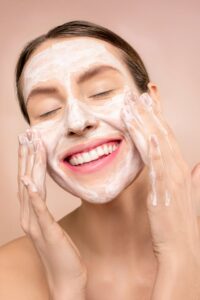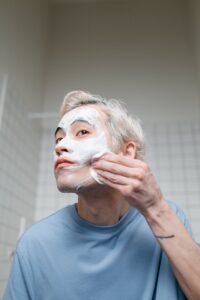The Power of Multi-Masking For Radiant, Healthy Skin
Understanding the concept of multi-masking can revolutionize your skincare routine. By applying different masks to specific areas of your face, this technique addresses multiple skin concerns simultaneously. Whether you have dry skin on your cheeks, an oily t-zone, or dull skin on your forehead, multi-masking allows you to target each area with the specific treatment it needs.
Understanding Multi-Masking

Photo by Shiny Diamond on Pexels
What is Multi-Masking? Multi-masking is a skincare technique where you apply different masks to different areas of your face to address multiple skin concerns at the same time. Rather than using just one mask for your entire face, you customize your skincare routine by treating various areas with masks that cater to their specific needs.
Benefits of Multi-Masking include the ability to purify, hydrate, exfoliate, and nourish different areas of your skin in one go. By using a combination of masks, you can brighten dull skin, address excess oil in your t-zone, and infuse hydration into dry areas, resulting in a more balanced and healthy complexion.
How Multi-Masking Addresses Multiple Skin Concerns: Multi-masking targets different skin concerns across various areas of your face. For instance, if you have combination skin with an oily t-zone and dry cheeks, you can apply a clay mask to your t-zone to purify and control oil production, while using a hydrating mask on your cheeks to replenish moisture and nourish the skin.
Choosing the Right Masks
When it comes to selecting the ideal masks for your multi-masking routine, it’s crucial to consider your skin type. Whether you have dry, oily, combination, or sensitive skin, there are masks designed to cater to your specific needs. Matching the right mask to your skin type ensures that you’re providing the most effective treatment for each area of your face.
Moreover, it’s essential to factor in the different skin concerns you want to address with multi-masking. Whether you’re looking to hydrate, purify, brighten, or exfoliate specific areas of your skin, choosing masks that target those concerns will help you achieve the desired results. By customizing your multi-masking routine based on your skin concerns, you can effectively treat multiple issues simultaneously.
Customizing a multi-masking routine involves strategically applying different masks to various areas of your face to address the unique needs of each zone. For instance, if you have an oily t-zone but dry cheeks, you can use a clay mask on the t-zone to control excess oil and a hydrating mask on the cheeks to replenish moisture. By tailoring your multi-masking approach, you can ensure that each part of your face receives the specific care it requires.
Application and Techniques
Properly applying multiple masks is key to maximizing the benefits of multi-masking. Start by cleansing your face to remove any impurities and allow the masks to penetrate deeply into your skin. Apply each mask to the targeted areas, ensuring an even layer for optimal results. Take into account the recommended leave-on time for each mask to avoid overexposure or underutilization of the product.
For an effective multi-masking experience, consider these tips to enhance the results. Avoid overlapping different masks to prevent mixing ingredients that may counteract each other’s benefits. Follow the order of application according to the needs of your skin, beginning with treatments that require more time to work effectively. Additionally, adjust the frequency of multi-masking based on your skin’s response and hydration levels to maintain a balanced complexion.
Best practices for multi-masking different areas of the face involve targeting specific concerns in each zone. For oily skin on the t-zone, use a clay mask to absorb excess oil and reduce shine. To address dryness on the cheeks, opt for a hydrating mask to restore moisture and nourish the skin. Tailoring the masks to the needs of each facial region ensures that you treat multiple skin concerns effectively and achieve a harmonious complexion.
Targeting Specific Skin Concerns

Photo by designundfotoart on Pixabay
When it comes to addressing skin concerns, multi-masking offers a tailored approach for different areas of your face. For dryness and hydration, consider using a hydrating mask on areas that lack moisture while focusing on a clay mask for oily zones. By customizing your masks, you can achieve balanced hydration levels and combat specific skin issues effectively.
Addressing Dryness and Hydration
To tackle dryness, opt for a hydrating mask rich in moisturizing ingredients like hyaluronic acid or glycerin. Apply this mask to areas of your face that lack moisture, such as the cheeks or chin, to replenish hydration levels and nourish the skin. Hydrating masks help in restoring the skin’s natural barrier and promoting a healthy, radiant complexion.
Treating Acne and Blemishes
For treating acne and blemishes, choose a mask that contains acne-fighting ingredients like salicylic acid or tea tree oil. Target these masks on areas prone to breakouts, such as the forehead or jawline, to reduce inflammation and combat excess oil production. Consistent use of acne-fighting masks can help in clarifying the skin and preventing future blemishes.
Handling Dullness and Uneven Skin Tone
To address dullness and uneven skin tone, consider using masks with brightening ingredients like vitamin C or niacinamide. Apply these masks to areas with hyperpigmentation or dull skin, such as the forehead or cheeks, to promote a more even complexion and enhance skin radiance. Brightening masks aid in fading dark spots and rejuvenating the skin’s appearance.
Maximizing Multi-Masking Results

Photo by Tomaz Barcellos on Pexels
Incorporating multi-masking into your skincare routine can amplify the benefits of individual masks and provide comprehensive care for your skin. By strategically selecting masks based on your skin’s needs and concerns, you can optimize the results and achieve a balanced and healthy complexion.
Incorporating Multi-Masking into Your Skincare Routine
Integrating multi-masking involves understanding your skin’s requirements and selecting masks that cater to specific concerns. By incorporating this technique regularly, you can address various skin issues simultaneously and tailor your skincare routine to meet the unique needs of each area of your face. Consistency in multi-masking can lead to noticeable improvements in skin texture and appearance.
Monitoring and Adjusting Based on Skin’s Response
It’s essential to monitor your skin’s response to multi-masking and adjust your routine accordingly. Pay attention to how each area of your face reacts to the masks and modify the application based on changes in your skin’s condition. By being attentive to your skin’s feedback, you can refine your multi-masking approach and optimize the benefits for a healthier complexion.
Sharing Multi-Masking Tips and Techniques
Sharing multi-masking tips with others can enhance their skincare experience and help them achieve radiant, healthy skin. By exchanging insights on mask combinations, application techniques, and skincare benefits, you can inspire others to try multi-masking and explore the versatility of this skincare method. Sharing knowledge and expertise in multi-masking fosters a community focused on achieving glowing, balanced skin.
Frequently Asked Questions (FAQs)
What is multi-masking?
Multi-masking is a skincare technique that involves applying different masks to different areas of your face based on your skin type and concerns in order to address multiple skin concerns at the same time.
How does multi-masking benefit my skin?
The benefit of multi-masking lies in its ability to address multiple skin concerns simultaneously. By targeting multiple skin concerns with specific masks, you can effectively treat dull skin, excess oil, dead skin, and more, optimizing your skin care routine.
What is a face mask?
A face mask is a skincare product that is applied to the skin to help hydrate, brighten, exfoliate, pore, or purify the skin, depending on the type of mask and skin concern.
How do I choose the right mask for my skin type?
It’s essential to consider your skin type and concerns when selecting a face mask. For example, if you have oily skin, you might opt for a clay mask to help purify. For dry skin, a hydrating mask that nourishes the skin could be more beneficial.
Can I multi-mask if I have combination skin?
Absolutely! Multi-masking is particularly beneficial for those with combination skin as it allows you to address multiple skin concerns in different areas of the face, such as an oily t-zone and dry chin.


